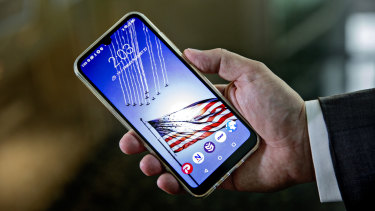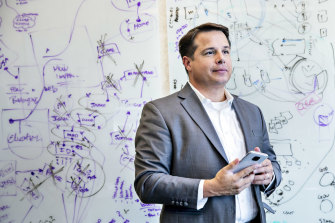It was a pitch tuned for a politically polarised audience. Erik Finman, a 22-year-old who called himself the world’s youngest bitcoin millionaire, posted a video on Twitter for a new kind of smartphone that he said would liberate Americans from their “Big Tech overlords.”
His splashy video, posted in July, had stirring music, American flags and references to former Presidents Abraham Lincoln and Donald Trump. Conservative pundits hawked Finman’s Freedom Phone, and his video amassed 1.8 million views. Finman soon had thousands of orders for the $US500 device.
Then came the hard part: Building and delivering the phones. First, he received bad early reviews for a plan to simply put his software on a cheap Chinese phone. And then there was the unglamorous work of shipping phones, hiring customer-service agents, collecting sales taxes and dealing with regulators.
“I feel like practically I was prepared for anything,” he said. “But I guess it’s kind of like how you hope for world peace, in the sense you don’t think it’s going to happen.”
For even the most lavishly funded startups, it is hard to compete with tech industry giants that have a death grip on their markets and are valued in the trillions of dollars. Finman was part of a growing right-wing tech industry taking on the challenge nonetheless, relying more on their conservative customers’ distaste for Silicon Valley than expertise or experience.
There are cloud providers hosting right-wing websites, a so-called free-speech video site competing with YouTube and at least seven conservative social networks trying to compete with Facebook.
In 2014, New York magazine profiled Finman as a 16-year-old from outside Coeur d’Alene, Idaho, who had struck it rich when, a few years earlier, he spent a $US1000 gift from his grandmother on Bitcoin.
By 2017, his riches had topped $US1 million and he was posting photos online of him posing with YouTube celebrities, getting on and off private jets, and lighting $US100 bills on fire. But he tired of the cryptocurrency scene.
Over the next several years, Finman said, he became worried about what he viewed as Silicon Valley censoring conservative voices. He also spotted a business opportunity in other Republicans who shared his concerns. So he aimed at the dominance of Apple and Google and tried to create a new right-wing smartphone.
“Politics is the new national pastime, baby,” Finman said. “Even non-political things like a freaking pillow end up becoming political,” he added, referring to Mike Lindell, the MyPillow founder, who has peddled lies about the 2020 election.
Reviews of the new phone have not been positive. CNET, the product-review site, said the $US500 device appeared to be “nearly on par with a $US200 budget Android phone.”Credit:Kim Raff/ The New York Times
To make a smartphone, however, he had to rely on Google. The company’s Android software already works with millions of apps, and Google makes a free, open version of the software for developers to modify. So Finman hired engineers to strip it of any sign of Google and load it with apps from conservative social networks and news outlets. Then he uploaded the software on phones he bought from China.
Google and Apple declined to comment.
To unveil the phone, he recorded an infomercial in which he cast the tech companies as enemies of the American way.
“Imagine if Mark Zuckerberg banned MLK or Abraham Lincoln,” he said in the video. “The course of history would have been altered forever.”
At the same time, a series of right-wing personalities pitched the phone to their followers. They stood to earn $US50 for every customer who used their discount codes.
Reviews of the new phone have not been positive. CNET, the product-review site, said the $US500 device appeared to be “nearly on par with a $US200 budget Android phone.”
Thousands of people bought the $US500 phone. Others, including some conservatives, quickly panned the animated pitch.
“It’s not a bad instinct,” said Zachary Graves, a tech-policy specialist at the Lincoln Network, a libertarian think tank. “But when I first saw the video, I was waiting for them to say ‘Live from New York, it’s Saturday night!’”
Quickly, news outlets reported that the Freedom Phone was based on a low-cost handset from Umidigi, a Chinese manufacturer that had used chips shown to be vulnerable to hacks. Finman, who marketed the device as “the best phone in the world,” was on the defensive.
In an interview in July, Finman admitted that Umidigi made the phone but still said he was “100 per cent” sure it was more secure than the latest iPhone. Apple has tens of thousands of engineers. Finman said he employed 15 people in Utah and Idaho.
Michael Proper’s company ClearCellular helped Finman created his phone. Credit:Kim Raff/The New York Times
Finman said he was not surprised by the criticism, but he was taken aback by the sales. That left him juggling responsibilities he had not planned for, including certification with the Federal Communications Commission and special rules for shipping devices with lithium batteries. He hired people from his hometown in Idaho to staff a makeshift customer-service center and he struggled to sort out sales-tax issues.
Within a month of the phone’s release, Finman had a solution: sell someone else’s phone and act as the branding frontman. Just as Finman’s political inspiration, Trump, has sold Trump steaks and Trump vodka without running a cattle ranch or a distillery, Finman unburdened himself of the difficult task of actually managing a company that makes phones.
“When the going gets tough, bring in the 50-something-year-olds,” Finman said. “They can be the ones with the sleepless nights.”
He teamed up with a 13-year-old firm in Orem, Utah, called ClearCellular, which had already created a phone that was disconnected from Apple and Google. The company also had experience with logistics, shipping and customer service.
The companies added the American Flag wallpapers and conservative apps to ClearCellular’s device and called it the Freedom Phone. Finman said the phone also has his “PatriApp Store,” though ClearCellular provides the technological support for the app store.
Finman will collect a cut, though they will not say how much.
Reviews of the new phone have not been positive. CNET, the product-review site, said the $US500 device appeared to be “nearly on par with a $US200 budget Android phone.”
Michael Proper, 46, the founder of ClearCellular, said Finman was “really building a brand.” Creating a phone company is ambitious, but “not only software, security, hardware, but supply chain, inventory and capitalisation,” he added. Finman’s strength is “connecting with folks inside of the freedom community.”
Finman said he had orders for about 12,000 Freedom Phones, putting revenue at around $US6 million in just over seven weeks. Finman and Proper said they had about 8,000 phones left to ship. Finman declined to connect The New York Times with any customers.
The New York Times
The Business Briefing newsletter delivers major stories, exclusive coverage and expert opinion. Sign up to get it every weekday morning.
Most Viewed in Technology
From our partners
Source: Read Full Article


